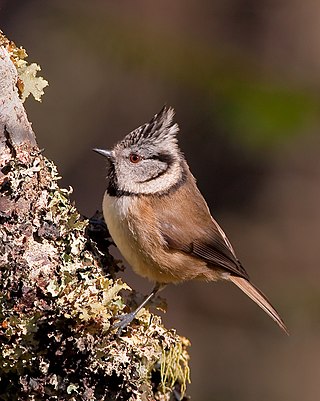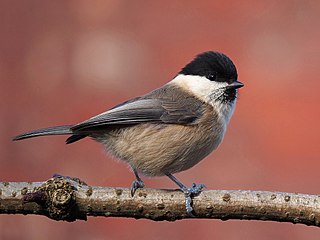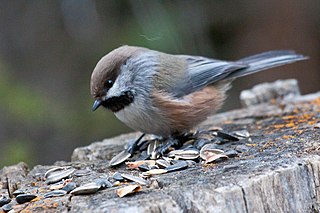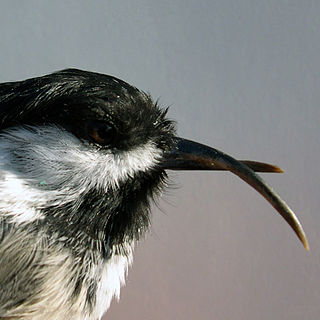
The tits, chickadees, and titmice constitute the Paridae, a large family of small passerine birds which occur mainly in the Northern Hemisphere and Africa. Most were formerly classified in the genus Parus.

The ground tit, Tibetan ground-tit or Hume's ground-tit is a bird of the Tibetan plateau north of the Himalayas. The peculiar appearance confused ornithologists in the past who called it as Hume's groundpecker and still later as Hume's ground jay or Tibetan ground jay assuming that it belonged to the family Corvidae that includes the crows and jays. Although morphologically confusing, the species has since been identified using molecular sequence comparisons as being a member of the tit family (Paridae) and is the only species in the genus Pseudopodoces. It is found in the Tibetan Plateau of China, India, Nepal & Bhutan.

The marsh tit is a Eurasian passerine bird in the tit family Paridae and genus Poecile, closely related to the willow tit, Père David's and Songar tits. It is a small bird, around 12 cm (4.7 in) long and weighing 12 g (0.42 oz), with a black crown and nape, pale cheeks, brown back and greyish-brown wings and tail. Between 8 and 11 subspecies are recognised. Its close resemblance to the willow tit can cause identification problems, especially in the United Kingdom where the local subspecies of the two are very similar: they were not recognised as separate species until 1897.

The willow tit is a passerine bird in the tit family, Paridae. It is a widespread and common resident breeder throughout temperate and subarctic Europe and across the Palearctic. The plumage is grey-brown and off-white with a black cap and bib. It is more of a conifer specialist than the closely related marsh tit, which explains it breeding much further north. It is resident, and most birds do not migrate.

The black-capped chickadee is a small, nonmigratory, North American passerine bird that lives in deciduous and mixed forests. It is a member of the Paridae family, also known as tits. It has a distinct black cap on its head, a black bib underneath, and white cheeks. It has a white belly, buff sides, and grey wings, back, and tail. The bird is well known for its vocalizations, including its fee-bee call and its chick-a-dee-dee-dee call, from which it derives its name.

The Carolina chickadee is a small passerine bird in the tit family Paridae.

The boreal chickadee is a small passerine songbird in the tit family Paridae. It is found in the boreal forests of Alaska, Canada and the northern United States and remains within this range all year. This bird is known for its high pitched trill patterns used in communication with other birds and food storage habits in preparation for winter months.

The grey-headed chickadee or Siberian tit, formerly Parus cinctus, is a passerine bird in the tit family Paridae. It is a widespread resident breeder throughout subarctic Scandinavia and the northern Palearctic, and also into North America in Alaska and the far northwest of Canada. It is a conifer specialist. It is resident, and most birds do not migrate. Curiously, the bird has no grey on its head, which is black, white, and brown.

The Himalayan black-lored tit, also known as simply black-lored tit, is a passerine bird in the tit family Paridae. The yellow-cheeked tit is probably its closest relative, and it may also be related to the yellow tit. These three tits almost certainly form a distinct lineage, as indicated by morphology, and mtDNA cytochrome b sequence analysis.

The mountain chickadee is a small songbird, a passerine bird in the tit family Paridae.

The Mexican chickadee is a small songbird, a passerine bird in the tit family Paridae. It is still often placed in the genus Parus with most other tits, but mtDNA cytochrome b sequence data and morphology suggest that separating Poecile more adequately expresses these birds' relationships. The American Ornithologists' Union had been treating Poecile as distinct genus for some time already.

The sombre tit is a member of the tit family found in southeast Europe and southwest Asia. Sombre tits occur in low density in thin woodlands at the elevation range between 1000 and 1600 metres above sea level. Similar to the other tit species, the sombre tit is a cavity-nesting species, which makes the nests in the holes in juniper, willow, poplar, and other relevant tree species. In some cases they nest in iron pipes, and in artificial nest-boxes. The clutch usually consists on 4 to 9 eggs, having two clutches per year. The species appear to be resident in the country with slight local movements. They breed on mountain slopes and in open deciduous forest; lower down on in trees and bushes in rocky terrain, as well as in fruit orchards. The breeding season lasts from early April till end of July - beginning of August. The food mainly consists on insects.

The chestnut-backed chickadee is a small passerine bird in the tit family, Paridae, native to western North America.

The white-browed tit is a species of bird in the tit family Paridae. It is endemic to the mountain forests of central China and Tibet.

Poecile is a genus of birds in the tit family Paridae. It contains 15 species, which are scattered across North America, Europe and Asia; the North American species are the chickadees. In the past, most authorities retained Poecile as a subgenus within the genus Parus, but treatment as a distinct genus, initiated by the American Ornithologists Union, is now widely accepted. This is supported by mtDNA cytochrome b sequence analysis.

The Caspian tit is a passerine bird in the tit family. It breeds in the deciduous mountain forests of northern Iran, just extending into Azerbaijan.

Avian keratin disorder (AKD) is an emerging disease among wild birds in North America characterized by overgrowth and deformities of beaks. Cases were first observed among black-capped chickadees in Alaska in the late 1990s, and it has spread rapidly since then. The cause of AKD is unknown, but may be Poecivirus, a species of virus within the family Picornaviridae that gained ICTV recognition in 2020.
Millicent S. Ficken, also known as Millicent Sigler Ficken, was an American ornithologist who specialized in birds' vocalizations and their social behaviors.


















